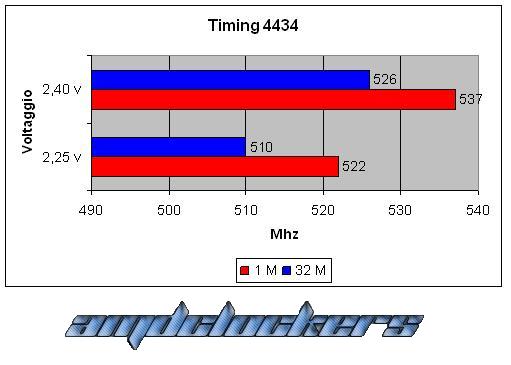The 2005 was characterized by the switching from AGP motherboards to Pci-E motherboards. The 2006 will be the 2x1GB kits DDR2 year, for who makes the PC not only a typewriter! Those guys who likes to play to the latest games like Battlefield 2, Half Life 2, Doom 3, Fear and so on will need more and more amount of memories, and often 1024MB of DDR won’t be enough! Same stuff for who works with high-level CAD drawing or who works on pictures or movies! We don’t have to forget that in less than a year the new O.S. Microsoft VISTA will be in our homes, and we know that he’s going to eat our 1GB kit of memories!!!
Last but not least we have to remind that even AMD is out with it’s new DDR2-ready platforms. Then the new Intel CPUs single core (6x1 series), dual cores (8x0 and 9x0 series) and the coming Conroe and Yonah CPUs will be running on the new 975x chipset that’s obligates us to mount DDR2 memories.
.jpg)
Let’s talk about this G.Skill… These modules are equipped by dark heat-spreader, with two black clips that hold everything together with the help of a thermal pad.
.jpg)
The PCB is a classic Brain-power one with 6 ULNs, now used by most of the high-end memories brands. While the chips mounted should be the Micron BT-3 since they react pretty fine in overclocking tests.
Memories Specs:
* Package : 2048MB kit (2x1024MB)
* CAS Latency : 4-4-4-5 (PC8000)
* Test Voltage : 2.2~2.3 V
* PCB Board : 6 Layers PCB
* Speed : DDR II 1000 MHZ (PC8000)
* Type : 240-pin DDR2 SDRAM
* Error Checking : Non-ECC
* Registered/Unbuffered : Unbuffered
* Quality Control :Comprehensive rigorously tested in pair at dual channel environment
* Warranty : Lifetime
We can consider this memories as High-end ones, the one in the 2gb kits field that goes from 400€ to 500€. This kit is guaranteed by G.skill at 500MHz (1000 MHz DDR2) with very low timings!
Thanks to the awesome heat-spreader G.skill could guarantee them to work with 2.2v, 2.3v which is a pretty high voltage, but this memories seems to like high it!
These memories seems to offer high performances, they seems to be very good for best video-gamers who doesn’t want to lose not even a single frame, or for the benchmarks lovers, always looking for more and more frames in the 3Dmark, or looking to lower their S-pi time!
TESTING PLATFORM:
Intel P4 631 cooled by Zalman 7000-b Cu
Asus P5WD2-E premium 975X bios 302
GSKILL F2-8000PHU2-2GBHZ
OCZ 520 Powerstream
NVIDIA 7600 GT POV
S.O. Windows 2003 server
Software used: Super-pi 1.4 Mod.
All the tests where made with two different voltage tensions:
=> 2.25v: to simulate the daily-use
=> 2.40v: to simulate the benchmark test, and to analyse the behaviour of this memories with the gain of volts.
For the Super-Pi tests were made two of them: 1MB to find the last MHz, and 32MB.
Looking at the Timings that we can change (generally from the Advanced Chipset Features menu in the motherboards bios), just four of them are the ones more used:
CAS Latency (Tcl): refers to the length of time, in clock cycles, it takes for a request sent from the memory controller to read a memory location and send it to the module's output pins. Lower values means higher performance. Obviously a Cas 3 implies different performance if the memory works at 166MHz or 200MHz!
RAS to CAS Delay (Trcd): the dates in the memories moduleds are disposed and read in raw and column, starting from the firsts lines and then from the columns. The TRCD means the delay in clock cycles between the RAS signal and the CAS one. Lower values means higher performances.
RAS Pre-charge Time (Trp): this value refers to the length of time, in clock cycles, between a RAS command the the next one. In this length of time the condensators of the memories are pre-charged. This operation is indispensable for the DRAM characteristic we told before. Obviously lower values means higher performances.
Cycle Time (Tras): refers to the length of time, in clock cycles, it takes to capture the date from the memory and making it avaible for the output. Lower values means higher performance.
The timings were set up by bios are in this order:
CAS-TRCD-TRP-TRAS.
This CPU has the multiplier locked, so we had to works in a-synchronised mode to test the stability at high frequencies: we used the 4/5, 3/5, 2/3 and ½ divisors







Conclusion:
As we can see from the various tests, the memories loves the gain of volts, with an improvement that run from 5% to 10% on the performance, both in the 1MB s-pi test and the 32MB one. We didn’t use higher timings because over 547MHz (1094 MHz DDR2) this kits couldn’t get in Windows, sure we found the physic limit of this chips, it is shown by the fact that relaxing the timings from 4434 to 4444 we didn’t have a significant improvement. The strength of this kit it’s the awesome performance, the lifetime warranty and the wonderful heat-spreader that with 2.40v allowed to maintain low the chip’s temperatures. We gave them the overall score of 4,5 over 5!



.jpg)
